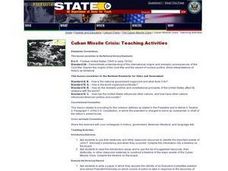Curated OER
Twelve Angry Men: Trial by Jury as a Right and as a Political Institution
Students explore the constitutional guarantee of the right to trial by jury. In this U. S. Constitution lesson, students read or view Twelve Angry Men and respond to discussion questions regarding the jury. Students examine the...
Curated OER
Letters, Telegrams, and Photographs Illustrating
Students research the factors that are important in winning a battle in the Civil War. In a second activity they are assigned the role of a specific type of person during the Civil War and asked to describe what it's like being that person.
Curated OER
Why a Bill of Rights? What Impact Does it Have?
Students explore the Bill of Rights. In this Bill of Rights activity, students compare the Federalist view of government to the Anti-Federalist view of government. Students consider the impact of the bill of rights as they take notes on...
Curated OER
The Supreme Court and the Fourteenth Amendment
Students examine the ratification of the Fourteenth Amendment. In this Reconstruction Era lesson, students read and analyze 4 Supreme Court decisions regarding the Fourteenth Amendment and determine how the decisions impacted citizen...
Curated OER
Treason and Trials - Aaron Burr
Students examine the Constitutional definition of treason and research the case of Aaron Burr as first interpreted in 1807. They consider how Burr's case relates to the case of John Walker Lindh.
Curated OER
Researching American Democracy
Students compare Watergate and the Clinton/Lewinsky scandal. In this U.S. Constitution lesson, students define vocabulary terms and read articles regarding the impeachment process. Students respond to questions that require them to...
Curated OER
FDR's Fireside Chat on the Purposes and Foundations of the Recovery Program
Learners discuss how they get information on important events or activities that occur in the national government today. They evaluate the New Deal, utilizing document analysis worksheets imbedded in this plan.
Curated OER
What's in the Water?
Students examine the Clean Water and Safe Drinking Water Acts. Using the text, they identify examples of how the federal and state governments implement public policy. They discuss how citizens can make sure that all levels of government...
Curated OER
Tribal Sovereignty Mock Trial
Students discuss the issue of tribal/native nation sovereignty. They review the Constitution of the U.S. and discuss how it legally provides for sovereign nations. Then they participate in a mock trial of the 1823 Supreme Court Case...
Curated OER
History of the Michigan Supreme Court from the Territorial Court and the founding of the Michigan Supreme Court in 1836 to Justice Mary S. Coleman and her interpretation of "One Court of Justice"
Students trace the history of the Michigan Supreme Court from when the state was still a territory. They define procedures as they relate to the Court. They compare and contrast the territorial court to the new Court.
Minnesota Courts
Inside Straight: the Third Branch
Learners use the worksheet as they view the film Inside Straight: the Third Branch. Multiple case studies and the history of the judicial branch of the US government are included via hyperlink and act as the topics of discussion...
Curated OER
Building the Foundation
Students understand the purpose of the judicial branch of government. In this judiciary lesson, students participate in exercises to understand how the court system works. Students complete activity sheets to develop understanding of...
Curated OER
The Decision to Americanize the War in Vietnam
Students research the major events of the Vietnam War and construct a timeline. They do the same with the presidency of Lyndon B. Johnson or the 1960's. They act as an advisor to President Johnson to recommend a course of action...
Curated OER
Cuban Missile Crisis: Teaching Activities
Students create a timeline of the important events of John F. Kennedy's presidency. They construct a timeline of the major events of the Cuban Missile Crisis. They compare the Missile Crisis events with their presentation in the movie...
Curated OER
Supreme Court: Practice with Precedents 2010
Eleventh graders examine the term precedent in the court system. In this American Government lesson, 11th graders research various court cases in history. Students create a study chart that shows comparisons of these cases.
Curated OER
Government: The Power Grab
Students are able to identify the departments and agencies within the executive branch that enforce energy policy. They are able to describe potential concerns that the executive branch must address when developing energy policy.
Curated OER
D-day Message from General Eisenhower to General Marshall
Students analyze a "top secret" document written by Eisenhower. They identify and chart cliches for those about to go into battle and read related poetry. They invite a veteran to describe the D-Day invasion.
Curated OER
Photograph and Pamphlet About Nuclear Fallout
High schoolers explore the term, 'nuclear fallout.' They analyze the "Facts about Fallout" pamphlet and list any questions that either were not answered by the pamphlet or arose as a result of materials provided.
Curated OER
Maps of Indian Territory, the Dawes Act, and Will Rogers' Enrollment Case File
Students, in groups, analyze one map at a time, first the 1885 map, then the 1891 map. After they have completed the analysis sheets, they compare the two maps and answer questions imbedded in the plan.




















